Aloe, Lu Hui 芦荟Lu Hui (TCM)Kumari (Ayurveda) Sibr (Unani) |

|

|
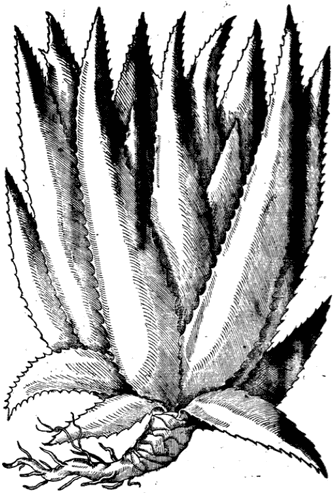
|
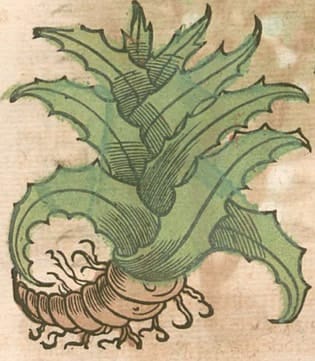
|
|
New Kreuterbuch, Matthiolus, 1563 |
Krauterbuch, Lonitzer, 1578 |
|
|
|
|
A. humilis Icones Plantarum Medcio-oeconomico, Vietz, 1806 |
A. perfoliata (Socrotine Aloes) Icones Plantarum Medcio-oeconomico, Vietz, 1800 |
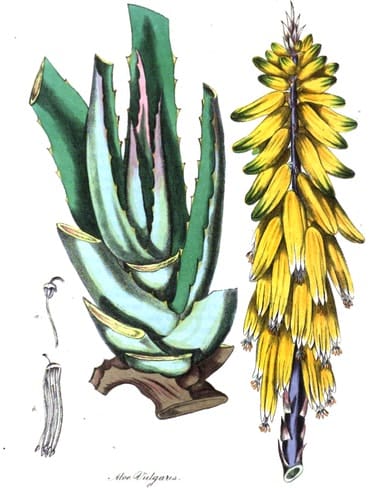
|
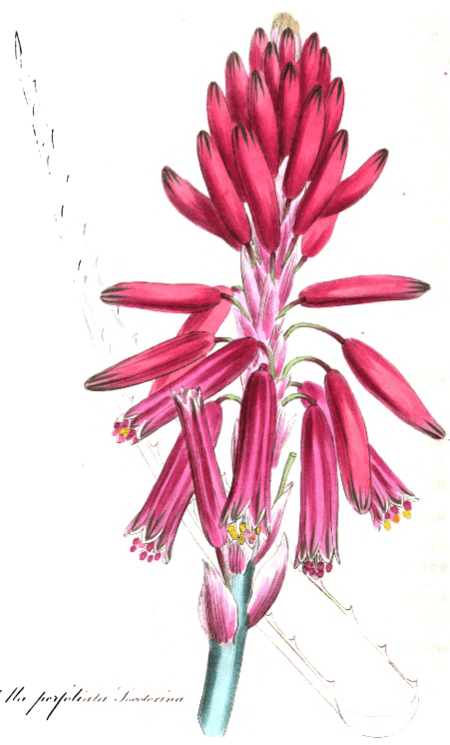
|
|
A. vulgaris (syn. A. barbadensis) Medical Botany, Bohn, 1832 |
A. perfoliata (Socrotine Aloes) Medical Botany, Woodville, Hooker, 1832 |
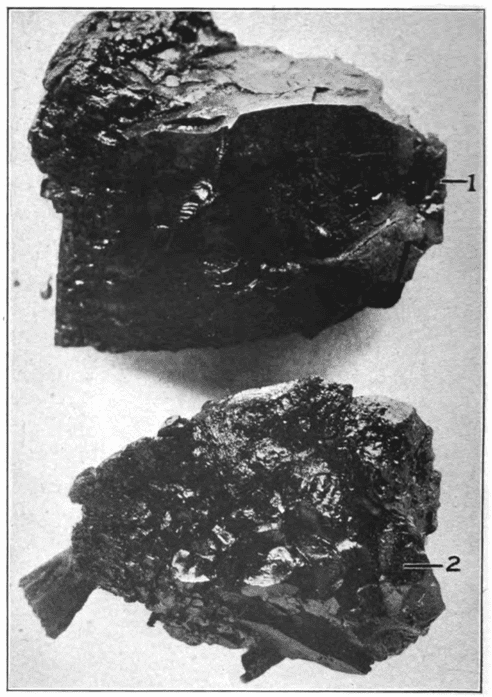
|
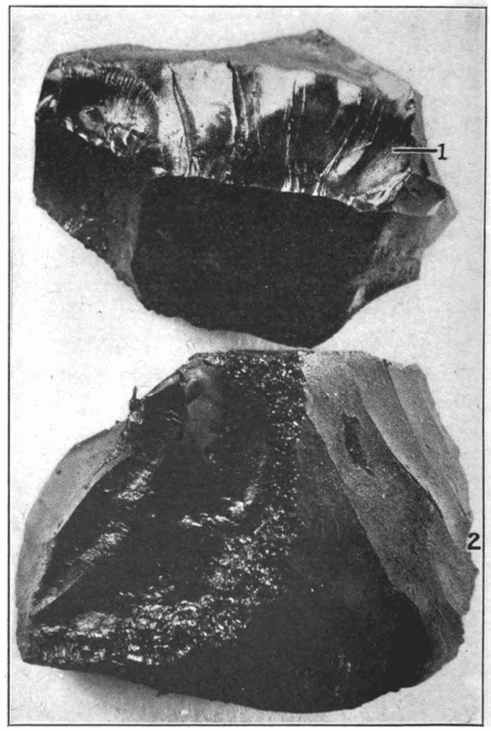
|
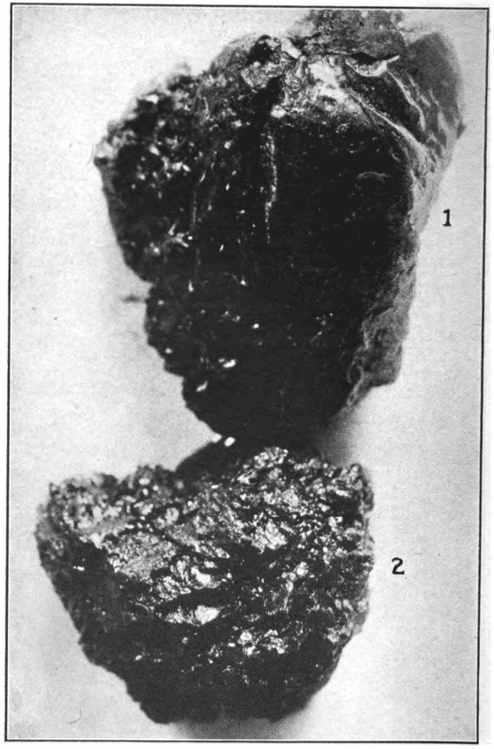
|
Squibb’s Atlas of the Official Drugs, Mansfield, 1919
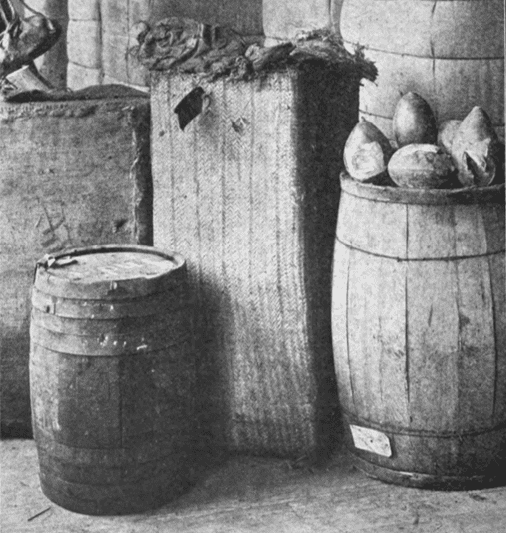
|
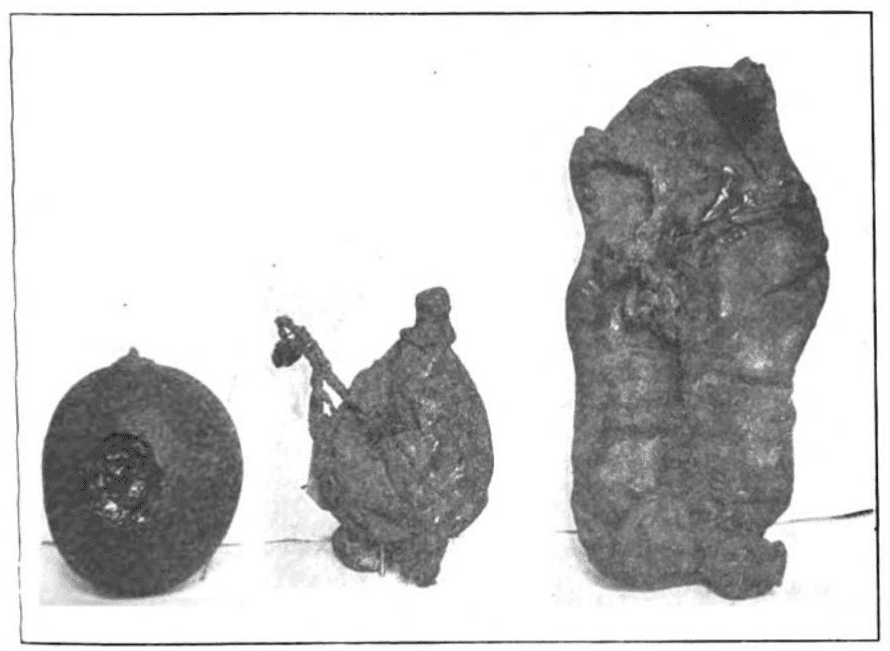
|
|
Aloe as imported in a Keg (Socrotine Aloes); 2 cases of ‘Monkey-skin Aloes’, one case with burlap, one with matting; Gourds emptied and filled with Aloes. Squibb’s Atlas of the Official Drugs, Mansfield, 1919 |
Traditional packaging for Aloes includes Gourds (left) and sewn up monkey skins (center & right) (A Manual of Organic Materia Medica and Pharmacognosy, Sayre, 1907) |
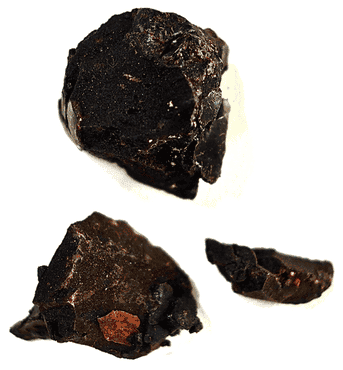 Dried Aloe juice (Adam 2016)
Dried Aloe juice (Adam 2016)Botanical name:
Aloe spp.
A. vera, A. barbadensis (syn. A. vulgaris, India), A. ferox (Africa), A. perryi (Arabia) and others
Salmon said in his day it was imported from Egypt, Arabia, East Indies, Jamaica, Asia, Syria, Italy and Spain.
The product on the market was traditionally divided into several types:
- Aloe Succrotina (from the Island Succrotina); is clear, transparent, and when powdered is a fine yellow color; this was accounted best; Sourced from A. socrotrina (syn A. vera), A. officianlis, A. rubescens
- Aloe Hepatica: Liver-colored, fine, clear; the poorer sort of this variety which is black was used for horses and called Aloe caballina. Sourced from various species, referring to a low quality product, chiefly from Succrotine Aloe
- Aloe Barbadoes, Curacao Aloes: similar to the previous, was imported in Gourds. Sourced from A. vulgaris (syn. A. perfoliata, A. barbadensis)
- Cape Aloes Sourced from A. ferox, A. africana, A. spicata, A. pefoliata; also A. aborescens, A. commelini, A. purpurascens
Parts used:
dried juice; prepared (‘washed’) juice; more recently, fresh juice is used.
Temperature & Taste:
Cold, dry (often classed as Warm in the Western Tradition); Bitter
“Hot up to the Second degree and is somewhat Dry” (Avicenna)
Classification:
2F. PURIFYING. 2G. CLEANSING. 2N. REPELLENTS. 2T. GLUTINATE. 2X. INCARNATIVE. 2Z. CICATRIZING
Preparers and Purgers of Phlegm. Preparers and Purgers of Melancholy. Preparers and Purgers of Bile
Uses:
1. Clears Heat, Purges Bile and Phlegm:
-purge in Bile and Bile-Phlegm (Damp-Heat) diseases. Suitable for purging in all cases of excess
-‘removes superfluous bilious matters from the head‘ (Avicenna)
-Headache, restlessness, insomnia, tinnitus
-congestion or obstruction of the abdominal organs from Heat or Heat and Phlegm (Damp-Heat)
-Hepatitis, Hepatic obstruction, Jaundice
-‘useful for treating Arthralgia‘ (Avicenna)
-Fever from excess Heat or Liver heat
-“disperses Heat resting in chest and diaphragm” (TCM: Kai Bao Ben Cao)
2. Drains Downward, Opens Obstructions
-acute constipation with Heat; Atony of the Bowel
-Promotes Menstruation when obstructed
-“treats infantile Convulsion and Epilepsy” (TCM: Kai Bao Ben Cao)
3. Promotes Digestion:
-‘restores lost appetite’ (Avicenna)
-small doses to stimulate appetite and digestion
-washed Aloes was most used in the West to strengthen the Stomach
-Childhood Nutritional Impairment (TCM)
-“The treated [washed] Aloe is a weaker purgative but it is more useful for the Stomach”. (Avicenna)
4. Resists Poison and Putrefaction
-internally and topically to clear Poison and resist putrefaction in Wounds, Sores etc.
-taken to prevent infection during Epidemics; to treat and heal Infectious diseases
-detoxifies Croton seed (TCM)
5. Benefits Heart, Purges Melancholy:
-with suitable herbs to purge Melancholy Humor
-“The classical system of medicine mentions that aloe purges out Black Bile and is useful in Melancholia” (Avicenna)
-‘Persian Aloe increases intelligence and strengthens the heart’ (Avicenna)
-Palpitations (Ben Cao Gang Mu)
6. Kills and Expels Worms
-“It Kills the Three Worms” (TCM: Kai Bao Ben Cao)
7. Externally:
-Bruises, Wounds, Ulcers, Sores especially of the Genitals, Gangrene
-difficult to cure Ulcers of the Anus, Penis, Eyes, Nose or Mouth. (Avicenna)
-powder is put into hollow teeth to relieve Toothache (West and TCM)
-heals Ulcerative Whitlow (Avicenna)
-Hemorrhoids, Anal Ruptures
-applied to Tumors and Cancers
-mixed with wine and applied to prevent falling of Hair. (Avicenna)
-applied with wine and honey to swellings of the Anus and Penis (Avicenna)
-mixed with honey and wine as a mouthwash for sores and Ulcers of the Mouth, Tongue or Gums
-applied with Honey to Scars (Avicenna)
-Tinea (TCM)
Dose:
1. Small doses stimulate digestion, open the Liver and have mild tonic effects. Moderate doses are laxative and have a stronger opening effect. Full doses purge strongly.
2. ‘given with any (other) purgative, the probability of harmful effects is reduced’. (Avicenna)
3. ‘Moreover pure aloe does not proceed to remote parts of the body and it does not even reach beyond the liver’. (Avicenna)
4. Generally only taken internally in powders, pills, or tinctures, and only in combination.
Powder and Pills: 200mg–4 grams (typically 300mg–1 gram). Large doses should be avoided today.
200–500mg is a small dose, 500–1500mg is a moderate dose; 2–4 grams is a large dose.
Avicenna said 5 grams is strongly purgative.
Used externally in oils, plasters, ointments etc.
Preparation:
1. Washed Aloe:
In the Western Tradition, washed Aloes was often used. The Aloe can be washed with water or Rose water. by stirring the powdered Aloe in the liquid, leaving to settle overnight, then pouring off the liquid and drying. This lessens its purgative effect, making it more mild and better for the young, old or weak. It was also regarded as better for strengthening the Stomach and promoting appetite and digestion.
Another method of washing from the Royal College of Physicians:
4 oz of the best Aloes is boiled in 1 quart of water until dissolved, then left to sit overnight. The resin will precipitate to the bottom of the vessel; the liquor poured off and strained, then evaporated, will leave a gum. This gum is less purgative, but more agreeable to the stomach than crude Aloes.
2. Aloe washed with Rose juice (Rosed Aloes, Aloes Rosata):
Aloe can be washed with juice of Rose. This increases its cooling effect while abating its purgative effect. It was preferred in conditions of deficiency and was used in formulas regarded as strengthening. It is the best form to use in the young, elderly and weak,
3. Aloe washed with Violet juice (Angelical Pills):
In the same manner as Rosed Aloes, Aloe may be prepared with Violet juice. This makes it more Cooling, but again abates its Purgative effect.
The same may be done with juices of Chicory, Borage, Bugloss or Fumitory. Sometimes, a number of different juices were used in the preparation of Aloes, drying between each juice, then proceeding with another juice.
4. Rhubarb prepared Aloe:
Aloe may be washed well in a decoction of Rhubarb, then dried. This enhances the Purgative effect. Rhubarb was also viewed as correcting the nature of Aloes.
5. Burnt Aloes:
Sometimes Aloe was roasted in a hot iron vessel until equally burnt. This was used in topical eye preparations.
Correctives:
1. Main correctives include Mastic, Nutmeg, Clove, Cinnamon and Saffron.
2. Mastic is the best corrective, removing its harsh quality.
3. Licorice also ameliorates its harshness.
4. Avicenna said Honey corrected Aloe.
5. Tragacanth (Unani)
6. Washed Aloes or Rose Aloes (Aloe prepared with Rose juice) also corrects Aloes.
7. In India it is corrective with Aniseed, Fennel, Cumin etc. (to settle Wind and griping).
8. Rhubarb: “When it is given with any purgative, the probability of harmful effects is reduced”. Rhubarb was generally said to correct the effect of Aloes.
9. Tragacanth and Bdellium: “Aloe produces purgation and cleanses the intestines. It also causes intestinal abrasion and opens the pores of veins (vasodilation). Gum Tragacanth reduces agglutinance and produces constipation. If Gum Tragacanth and Bdellium are used along with it, the former, by producing agglutinance, would remove intestinal abrasion caused by Aloe while the latter would restore strength to the pores of the veins and thus safety would be achieved”. (Avicenna)
Substitutes:
1. ‘Double quantity of the extract of Barberry (Berberis aristata) is considered to be its substitute’. (Avicenna)
2. Turbith (Unani)
Main Combinations:
Aloe & Myrrh
Aloe & Rose
Many formulas are based on the combination of Aloe, Myrrh and Saffron. This is the original Pills of Ruffus, or Common Pills. They were highly regarded to prevent against infectious of Epidemic Diseases including the Plague. Additions include Gentian, Rhubarb, Zedoary, Angelica etc. This is also the original basis of Swedish Bitters.
Purgative:
1. To Purge Bile:
i. Dissolve Aloes in Rose juice, then dry. This is milder than raw Aloes but effective to purge Bile.
ii. combine Aloe with Rose, Yellow Myrobalan, Rhubarb, Sandalwood, Gentian etc.
2. To Purge Phlegm, Aloe with Agaric, Turbith, Myrrh etc.
3. To Purge Melancholy, Aloe with Black Myrobalan, Dodder, Polypody, Agaric etc.
4. To Purge Congealed Blood, Aloe with Myrrh, Madder, Saffron, Zedoary, Rhubarb etc.
5. To strengthen the Stomach, clear Phlegm and Damp:
i. Aloe with Mastic, Rose, made into pills with Syrup of Wormwood
ii. Aloe with Mastic, Agaric, made into pills with Mint Water. (Dispensatorium Pharmaceuticum, 1777)
6. Cholagogue:
i. Aloe with Gentian
ii. Aloe with Gentian, Myrrh, Wormwood
Gynecology:
7. To promote Menstruation:
i. Aloe taken with Mugwort water
ii. Aloe with Myrrh, Horehound
iii. Aloe with Myrrh, Saffron, prepared Iron
iv. Aloe, Myrrh, Saffron (equal parts), form pills with Syrup of Orange peel (Richter)
v. Aloe with Dandelion root, Yarrow, Rue, Rosemary (Kroeber)
vi. Aloe (8 grains), Savin (6 grains), Licorice powder (2 scruples), divide into 6 doses, one every 3 hours. (Picettario Clinico, Padua, 1825)
vii. Aloe with Myrrh, Gentian, Dittany, Madder (Memorial Pharmaceutique, 1824)
viii. Aloe with Senna, Asafetida, Myrrh, Galbanum, Iron sulphate, Saffron, make pills with Syrup of Mugwort. (Pharmacopoeia Hispana, 1798)
ix. Aloe with Myrrh, Gum Ammoniac, Borax, Iron oxide, Rue, Savin (Pharmacopee Usuelle, Louvain, 1821)
8. To cleanse the Uterus:
i. Aloe with Myrrh, Madder, Saffron
ii. Aloe with Myrrh, Turmeric (Ayurveda)
9. Hysteria:
i. Aloe with Asafetida
ii. Aloe with Galbanum, Castoreum, Asafetida, Rue, Wormwood, Tansy, Savin
Joint disease:
10. Arthritis, Rheumatism, Joint disease:
i. Aloe with Myrrh, Rhubarb, Agaric
ii. Aloe with Colchicum, Yellow Myrobalan, Turbith, Ginger (Mesue)
11. Scoliosis, crookedness of the back, Aloe with Bdellium, Celery seed
Liver and Spleen:
12. Jaundice, Liver Tumor, Liver Sclerosis, Cirrhosis, Liver Obstruction Aloe with Agrimony and Yellow Myrobalan (as in Pills of Agrimony Lesser of Mesue)
13, Obstruction of the Spleen, Aloe, Mastic, Scolopendra
Other:
14. Cough:
i. Aloe with Agaric, Mastic, Hyssop (Issac)
ii. Aloe, Myrrh, Licorice, Aniseed
15. Asthma:
i. Aloe with Mastic, Licorice juice, Licorice root (Dorsten, 1540)
i. Aloe with Agaric, Mastic, Hyssop (Issac)
16. Catarrh:
i. Aloe with Amber, Mastic, Agaric
ii. Aloe, Agaric, Fennel seed
17. Edema:
i. Aloe, Mastic, form pills with Wormwood juice (Dorsten, 1540)
ii. Aloe, Squill, Parsley seed
18. Thirst, Aloe with Cabbage juice made into pills the size of a chickpea (Galen)
19. Worms:
i. Roundworm, take the powder alone (Ben Cao Gang Mu)
ii. Aloe powder taken with Honey
iii. Aloe with Wormwood (Picettario Clinico, Padua, 1825)
iv. Aloe with Asafetida, Gentian, Camphor, Orange peel (equal parts), Saffron (a little), made into a tincture.
v. Aloe with Colocynth, Savin, Wormwood, Tansy, use the strong decoction as a foment. (Dispensatorium Pharmaceuticum, 1777)
vi. Aloe mixed with Bile and applied to the navel in children.
vii. Aloe with Asafetida, Wormwood, Tansy, as a cataplasm with Linseed oil, applied to the abdomen. (Formulaire de Montpellier, 1822)
viii. Aloe with Rhubarb, Gentian, Myrrh, Fern root, Wormwood, Wormseed, Centaury, Ox Bile (Formulaire de Montpellier, 1822)
External:
20. Eyesight:
i. tearing and to benefit vision, Aloe washed with Rose water or Fennel juice is applied around the eye (Dorsten, 1540)
ii. to cleanse and preserve the Eyesight, Aloe with Valerian, Eyebright, Fennel seed, Sandalwood, Lesser Cardamon, Agaric, Amber (Pharmacopoeia Wirtembergica, 1798)
iii. Collyrium for the Eyes, Aloes (1 dram), Rose Water, White Wine (1 ½ oz. each), Tincture of Saffron (30 drops). Boil the Aloes in the wine, then mix with the remaining. (Memorial Pharmaceutique, 1824)
21. Headache, Aloe mixed with Rose oil and applied to the temples and forehead (Avicenna)
22. Wounds, Bruising, Trauma, Gangrene, Aloe with Myrrh as a Tincture (as in Tincture of Myrrh and Aloes)
23. Putrid Wounds and Pustules, Aloe with Myrrh, Dragon’s Blood to clear foul and dead flesh. (Dorsten, 1540)
24. Eczema, Aloe (1 part), Licorice (half part), wash the place with wine, then apply the powder. (Su Song)
25. Fistulas of the Breast, wash it daily with Wine in which Myrrh has been boiled. Then mix Sarcocolla and Aloe with Honey, adding a little Bile and put into a linen bag and insert in the Fistula ‘and with this most certainly you shall have your purpose’. (The Secrets of Alexis, 1615)
26. Abscess of the Penis, after Bloodletting, wash well with Aloe dissolved in wine. (The Secrets of Alexis, 1615)
27. Bruising, pain, inflammation:
i. Aloe, Myrrh (2 oz. each), Olibanum (1 oz.), prepare an ointment, plaster, or oil.
ii. Aloe, Myrrh, Saffron
iii. Aloe, Myrrh, Dragon’s Blood, Rhubarb
Major Formulas:
Powder to Purge Bile (Mesue)
Arabian Pills (Nicholas)
Aromatic Pills of Aloes (Sweet Pills of Aloe, Pilulae Aloephangine) (Mesue)
Common Pills
The Count’s Night Pills (Unani)
Frankfurt Pills
Golden Pills (Nicholas)
Greater Polycrest Pills
Hiera Picra
Hiera Theodoretus
Lesser Pills of Cochia
Imperial Pills
Magisterial Imperial Pills
Pestilential Pills of Basil
Pills Against Pestilence Magistrale
Pills of Aloe (Unani)
Pills of Amber
Pills for Cataracts
Pills for Joint Disease
Pills for many Diseases of the Body
Pills for Mixed Humors (Mesue)
Pills for Pestilence
Pills of Ten Things (Unani)
‘Pills without which I would not be’ (Nicholas)
Stomach Pills (Mesue)
Rosed Aloes (Aloe Rosata)
Elixir Vitae (Tincture of Life)
Tincture of Myrrh and Aloes
Boladi Vati (Ayurveda)
1. Wine of Aloes:
i. Aloe (8 oz.), Canella bark (2 oz.), Proof Spirit, Distilled Water (4 pints each). Powder the Aloe and bark and macerate for 14 days, shaking frequently. (London)
ii. Aloe (1 oz), Cardamon seed, Ginger (1 dram each), Spanish Wine (2 pints). Digest 7 days, shaking often, strain. (Edinborough)
2. Elixir of Long Life:
i. Rhubarb, Zedoary, Gentian, Agaric, Saffron, Treacle (1 dram each), Proof Spirit (32 oz.). Digest a few days then add Aloe (9 drams). (Pharmacopee Usuelle, Louvain, 1821)
ii. some versions replaced Zedoary with Cinnamon; some versions omitted both Zedoary and Cinnamon.
Cautions:
1. Not used in purgative doses in deficiency
2. Not used during Pregnancy
3. Not used daily for more than 2 weeks. Most typically, it was used in compounds once or twice weekly if used on a long-term basis.
4. ‘The oral use of Aloe in Winter is dangerous… When taken in Winter, it might cause hemorrhagic diarrhoea‘. (Avicenna)
Toxicity:
Aloe vera-induced acute liver injury: A case report and literature review.
Main Preparations used:
Prepared Aloes, Purified Aloes, or Extract of Aloes, Tincture of Aloes, Stabilised Aloe Juice, Aloes Violata, Aloes Rosata, Purging Oil of Aloes, Suppository of Aloes
1. EXTRACT OF ALOES, or PURIFIED ALOES:
i. Aloe powder (1 pound), boiling Water (1 gallon). Macerate 3 days with a gentle heat, strain, set aside to let the dregs settle. Pour off the clear liquor and evaporate.
ii. The powder of Aloes is digested with S.V. [Brandy] (or some distilled water) in some gentle heat for 2 days; it is then decanted, and abstracted to the desired consistency
2. TINCTURE OF ALOES:
i. Aloes (½ oz.), Extract of Licorice (1 ½ oz.), Boiling Water, Proof Spirit (½ pint each). Dissolve the extract in boiling water, then mix all and digest 7 days. Dose: 1 scruple–1 dram or more (Dublin)
3. STABILIZED ALOE JUICE.
Fresh Aloe leaf 300 grams
Water 250 mls.
Honey 50 grams
Cut the spikes of the leaves, chop and beat them. Mix the honey and water, and gently bring to the boil, removing the scum as it rises. Pour this Hydromel over the leaves, and mix well, then squeeze the leaves, and then strain the extract.
This can be used for all the purposes of the fresh leaf juice.
Dose: 5-15 mls. (1-3 teaspoonfuls)
4. ALOE ROSATA.
Aloe powder 4 oz.
Damask Rose juice, clarified 1 lb.
‘Mix. Digest in the Sun till superfluous liquor be drawn off, digest it, evaporate 4 times and form pills’.
Clears heat, cleanses the Stomach. Good for problems from heat and phlegm blocking, such as Yellow Jaundice etc. If Amber and Myrrh are added, this formula is very good to strengthen, cleanse and ‘recreate’ the Stomach and Womb
5. ALOE VIOLATA, ANGELICAL PILLS, or FRANKFURT PILLS (Grulingius)
Take Aloes and dissolve in the juice of Violets; strain, and inspissate to the thickness of an Extract.
Dissolve the Aloes again in double their weight of fresh Violet juice; evaporate, and form into pills. These were often formed into very small pills, each weighing about half a grain.
These pills were famed throughout Europe for quite a long time. Their recipe was kept very secret, and in fact Schroder was actually forbidden to publish the 2 ingredients. It is used the same as Aloes but is much safer and more pleasant to use than raw Aloes.
Used to cleanse corruption from the Stomach and Bowels, as well as opening the Liver, Spleen and Intestines. Dose: 5-15 or 20 grains, or 0.5 dram; 1 scruple can be taken for 30 days. (Salmon, French Pharmacopoeia)
6. SUPPOSITORY
Aloe powder 2 ½ parts
Cocoa butter 12 ½ parts
Mix.
- More Info
- Varieties
-
History
-
Research
|
1. Socotrine Aloes— also called Bombay, East Indian, or Zanzibar Aloes, and when opaque and liver-coloured, Hepatic Aloes. It is imported in kegs and tin-lined boxes from Bombay, whither it has been carried by the Arab traders from the African coast, the Red Sea ports, or by way of Zanzibar, from Socotra. When of fine quality, it is of a dark reddish-brown, of a peculiar, rather agreeable odour, comparable to myrrh or saffron. In thin fragments, it is seen to be of an orange-brown; its powder is of a tawny reddish-brown. When moistened with spirit of wine, and examined in a thin stratum under the microscope, good Socotrine Aloes is seen to contain an abundance of crystals. As imported, it is usually soft, at least in the interior of the mass, but it speedily dries and hardens by keeping. It is occasionally imported in a completely fluid state (Liquid Socotrine Aloes, Aloe Juice), and is not unfrequently somewhat sour and deteriorated. Some fine aloes from Zanzibar, of which a very small quantity was offered for sale in 1867, was contained in a skin, and composed of two layers, the one amorphous, the other a granular translucent substance of light colour, which when softened and examined with a lens, was seen to be a mass of crystals. A very bad, dark, foetid sort of aloes is brought to Aden from the interior. It seems to be the Moka Aloes of some writers. The quantity of aloes imported into Bombay in the year 1871-72 was 892 cwt., of which 736 cwt. are reported as shipped from the Red Sea ports and Aden. 2. Barbados Aloes— Characteristic samples show it as a hard dry substance of a deep chocolate-brown, with a clean, dull, waxy fracture. In small fragments it is seen to be translucent and of an orange-brown hue. When breathed upon, it exhales an odour analogous to, but easily distinguishable from, that of Socotrine aloes. It is imported in boxes and gourds. The gourds, into which the aloes has been poured in a melted state through a square hole, over which a bit of calico is afterwards nailed, contain from 10 to 40lb. or more. Of late years, Barbados aloes having a smooth and glassy fracture has been imported ; it is known to the London drug-brokers as “Capey Barbados.” By keeping, it passes into the usual variety having a dull fracture. The export of aloes from Barbados in 1871, as shown by the Blue Book for that colony, was 1046cwt., of which 954cwt. were shipped to the United Kingdom. |
3. Curacao Aloes—manufactured in the Dutch West Indian islands of Curasao, Bonaire, and Aruba, is imported into this country by way of Holland, packed in boxes of 15 to 28 lb. each. In appearance it resembles Barbados aloes, but has a distinctive odour. 4. Cape Aloes—The special features of this sort of aloes are its brilliant conchoidal fracture and peculiar odour. Small splinters seen by transmitted light are highly transparent and of an amber colour; the powder is of a pale tawny yellow. When the drug is moistened and examined under the microscope, no crystals can be detected, even after the lapse of some days. Cape aloes has the odour of other kinds of aloes, with a certain sourish smell which easily distinguishes it. Several qualities are recognized, chiefly by the greater or lesser brilliancy of fracture, and by the tint of the powder. From the Blue Book for the Colony of the Cape of Good Hope, published at Cape Town in 1873, it appears that the export of aloes in 1872 was 484,532 lb. (4326 cwt.); and that the average market value during the year was 3 3/4d., the lowest price, 1 1/2d., being at Riversdale and Mossel Bay, and the highest, 11d., at Swellendam. The drug is shipped from Cape Town, Mossel Bay and Algoa Bay. 5. Natal Aloes— Aloes is also imported from Natal, and since 1870 in considerable quantity. Most of it is of an hepatic kind and completely unlike the ordinary Cape aloes, inasmuch as it is of a greyish-brown and very opaque. Moreover it contains a crystalline principle which has been found in no other sort of aloes. The drug is manufactured in the upper districts of Natal, between Pietermaritzburg and the Quathlamba mountains, especially in the Umvoti and Mooi River Counties, at an elevation of 2000 to 4000 feet above the sea. The plant used is a large aloe which has not yet been botanically identified. The people who make the drug are British and Dutch settlers, employing Kaffir labourers. The process is not very different from that followed in making Cape aloes, but is conducted with more intelligence. The leaves are cut obliquely into slices, and allowed to exude their juice in the hot sunshine. The juice is then boiled down in iron pots, some care being taken to prevent burning, by stirring the liquid as it becomes thick. The drug while still hot, is poured into wooden cases, in which it is shipped to Europe.’ (Pharmacographia, Fluckiger & Hanbury, 1879) |
|
‘The aloe bears a resemblance to the squill, except that it is larger, and has more substantial leaves, with streaks running obliquely. The stem is tender, red in the middle, and not unlike that of the anthericus. It has a single root, which runs straight downwards, like a stake driven into the ground; its smell is powerful, and it has a bitter taste. The most esteemed aloes are those imported from India, but it grows in the Asiatic provinces aswell. This last kind, however, is never used, except that the leaves are applied fresh to wounds; indeed, these leaves, as well as the juice, are glutinous to a marvellous degree, and it is for this property that it is grown in vessels of a conical form, in the same way as the greater aizoiim. Some persons make incisions in the stem to obtain the juice, before the seed is ripe, while others, again, make them in the leaves as well. Tear like drops are also found adhering to it, which exude spontaneously: hence it is that some recommend that the place should be paved where it is grown, to prevent this juice from being absorbed. ‘Some authors have stated, that there is found in Judaea, beyond Hierosolyma, a mineral aloe, but that it is inferior to the other kinds, being of a darker colour and more humid than any of the rest. Aloes of the finest quality should be unctuous and shining, of a red colour, brittle, compact, like the substance of liver, and easily liquefied. That which is hard and black should be rejected; the same, too, when it is mixed with sand or adulterated with gum and acacia, a fraud which may be easily detected by the taste. ‘This plant is of an astringent nature, binding, and slightly calorific. It is employed for numerous purposes, but principally as a purgative, it being almost the only one of all the medicaments which produce that effect, that is at the same time a good stomachic, and does not exercise the slightest noxious influence upon the stomach. It is taken in doses of one drachma, and, in cases of derangement of the stomach, it is administered two or three times a day, in the proportion of one spoonful to two cyathi of warm or cold |
water, at intervals, according to the nature of the emergency. As a purgative it is mostly taken in doses of three drachma:; and it operates still more efficaciously, if food is eaten directly afterwards. Used with astringent wine, it prevents the hair from falling off, the head being rubbed with it the contrary way of the hair, in the sun. Applied to the temples and forehead with rose oil and vinegar, or used as an infusion, in a more diluted form, it allays head-ache. It is generally agreed that it is remedial for all diseases of the eyes, but more particularly for prurigo and scaly eruptions of the eye-lids; as also for marks and bruises, applied in combination with honey, Pontic honey in particular. ‘It is employed, also, for affections of the tonsillary glands and gums, for all ulcerations of the mouth, and for spitting of blood, if not in excess—the proper dose being one drachma, taken in water or else vinegar. Used by itself, or in combination with vinegar, it arrests haemorrhage, whether proceeding from wounds or from other causes. In addition to these properties, it is extremely efficacious for the cure of wounds, producing cicatrization very rapidly: it is sprinkled also upon ulcerations of the male organs, and is applied to condylomata and chaps of the fundament, either in common wine, raisin wine, or by itself in a dry state, according as a mollifying or restrictive treatment is required. It has the effect, also, of gently arresting hemorrhoidal bleeding, when in excess. In cases of dysentery, it is used as an injection, and where the digestion is imperfect it is taken shortly after the evening meal. For jaundice, it is administered in doses of three oboli, in water. As a purgative for the bowels, it is taken in pills, with boiled honey or turpentine. It is good also for the removal of hangnails. When employed in ophthalmic preparations, it is first washed, that the more gravelly portions of it may subside; or else it is put over the fire in a pipkin, and stirred with a feather from time to time, that the whole of it m a y be equally warmed. (The Natural History of Pliny, trans. by Bostock and Riley, Vol. 5, 1856) |
Pharmacographia, Fluckiger & Hanbury, 1879
|
‘Aloes was known to the Greeks as a production of the island of Socotra as early as the 4th century B.C., if we might credit a remarkable legend thus given in the writings of the Arabian geographer Edrisi. When Alexander had conquered the king of the Persians and his fleets had vanquished the islands of India, and he had killed Pour, king of the Indies, his master Aristotle recommended him to seek the island that produces Aloes. So when he had finished his conquests in India, he returned by way of the Indian Sea into that of Oman, conquered the isles therein, and arrived at last at Socotra, of which he admired the fertility and the climate. And from the advice which Aristotle gave him he determined to remove the original inhabitants and to put Greeks in their place, enjoining the latter to preserve carefully the plant yielding aloes, on account of its utility, and because that without it certain sovereign remedies could not be compounded. He thought also that the trade in and use of this noble drug would be a great advantage for all people. So he took away the original people of the island of Socotra, and established in their stead a colony of Ionians, who remained under his protection and that of his successors, and acquired great riches, until the period when the religion of the Messiah appeared, which religion they embraced. They then became Christians, and so their descendants have remained up to the present time {circa A.D. 1154). ‘This curious account, which Yule says is doubtless a fable, but invented to account for facts, is alluded to by the Mahomedan travellers of the 9th century and in the 10th by Masudi, who says that in his time aloes was produced only in the island of Socotra, where its manufacture had been improved by Greeks sent thither by Alexander the Great. ‘Aloes is not mentioned by Theophrastus, but appears to have been well known to Celsus, Dioscorides, Pliny and the author of the Periplus of the Erythrean Sea, as well as to the later Greek and the Arabian physicians. From the notices of it in the Anglo-Saxon leech-books and a reference to it as one of the drugs recommended to Alfred the Great by the Patriarch of Jerusalem, we may infer that its use was not unknown in Britain as early as the 10th century. ‘At this period and for long afterwards the drug was imported into Europe by way of the Red Sea and Alexandria. After the discovery of a route to India by the Cape of Good |
Hope the old line of commerce probably began to change. Pires, an apothecary at Cochin, in a letter on Eastern drugs addressed to Manuel, king of Portugal, in 1516, reports that aloes grows in the island of Cacotora, Aden, Cambaya, Valencia of Arragon, and in other parts,— the most esteemed being that of Cacotora, and next it that of Spain; while the drug of Aden and Cambaya is so bad as to be worthless. ‘In the early part of the 17th century there was a direct trade in aloes between England and Socotra; and in the records of the East India Company there are many notices of the drug being bought of the “King of Socotra.” Frequently the king’s whole stock of aloes is mentioned as having been purchased. ‘Wellstead, who travelled in Socotra in 1833, says that in old times the aloe was far more largely grown there than at present, and that the walls which enclosed the plantations may still be seen. He adds that the produce was a monopoly of the Sultan of the island. At the present day the few productions of Socotra that are exported are carried by the Arab coasting vessels, coming annually from the Persian Gulf to Zanzibar, at which place they are transhipped for Indian and other ports. Dr. Kirk, who has resided at Zanzibar from 1866 to 1873, informs us that aloes from Socotra arrives in a very soft state packed in goat skins. From these it is transferred to wooden boxes, in which it concretes, and is shipped to Europe and America. To avoid loss the skins have to be washed; and the aloetic liquor evaporated. ‘Ligon, who visited the island of Barbados in 1647-50, that is about twenty years after the arrival of the first settlers, speaks of the aloe as if it were indigenous, mentioning also the useful plants which had been introduced. At that period the settlers knew how to prepare the juice for medicinal use, but had not begun to export it. Barbados aloes was in the drug warehouses of London in 1693. ‘The manufacture of aloes in the Cape Colony of South Africa was observed by Thunberg in 1773 on the farm of a boer named Peter de Wett, who was the first to prepare the drug in that country. Cape Aloes is enumerated in the stock of a London druggist in 1780, its cost being set down as £10 per cwt. (1s. 9 1/2d. per lb). ‘A new and distinct sort of aloes, manufactured in the colony of Natal, appeared in English commerce in 1870. |
